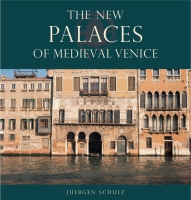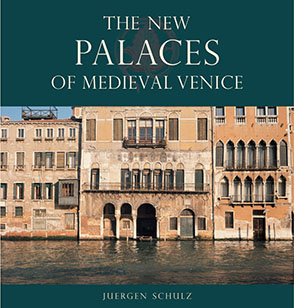The New Palaces of Medieval Venice
Juergen Schulz
“A splendid accomplishment, overwhelming in its mastery of sources and scholarship, that makes its arguments with nerve and verve, and unlike most scholarship leaves the reader with a poignant sense of the effects of time on historical artifacts and persons.”
- Media
- Description
- Reviews
- Bio
- Table of Contents
- Sample Chapters
- Subjects
Winner of a 2005 Choice Outstanding Academic Title
An internationally recognized expert on Venetian art, architecture, and cartography, Schulz examines the city’s medieval palaces with scholarship of unprecedented breadth and insight. Based in both archival research and first-hand knowledge of Venice, his book reconstructs the original appearance of the city’s oldest surviving residences, such as that of the Corner and Pesaro families, and traces the many later modifications made to these buildings. Further, Schulz’s book breaks new ground by presenting a systematic discussion of the use of sculpture in Venice’s early palaces, famed for their "exhibitionistic"’ scale and ornament.
Illustrated with numerous photographs and plans, The New Palaces of Medieval Venice provides a comprehensive account of the ways in which a group of buildings came to embody the lives of Venice’s leading mercantile families. Schulz’s discussion of the Venetian palaces’ impact on later architecture further enhances the significance of this handsome publication.
“A splendid accomplishment, overwhelming in its mastery of sources and scholarship, that makes its arguments with nerve and verve, and unlike most scholarship leaves the reader with a poignant sense of the effects of time on historical artifacts and persons.”
“It is impossible to exaggerate the importance of this book. Any summary can only skim the surface of the depth of observation and fullness of information contained within its pages. Schulz’s rich career of scholarship on the history and art of Venice has culminated in a punctilious and inspired production. It is a powerful demonstration of what happens when the grunt work of archival research and a vivid response to the visual merges with a deeply felt understanding of historical developments. Venice will never look the same.”
“However, as a means of stimulating debate and questioning long-held assumptions, these are important issues to raise, and in so doing, Schulz has done us a great service in this fine work. I only need to add that it is beautifully produced, has excellent illustrations, and is superbly edited.”
“Many years ago, Juergen Schulz took it upon himself to tackle one of the most elusive and challenging fields of Venetian architectural history, the origins and early development of the casa da stazio of the merchant nobility. This masterly book is effectively the culmination of that enterprise.”
“Schulz’s rich career of scholarship on the history and art of Venice has culminated in a punctilious and inspired production. It is a powerful demonstration of what happens when the grunt work of archival research and a vivid response to the visual merges with a deeply felt understanding of historical developments. Venice will never look the same.”
“There is only one word needed to describe this book: indispensable.”
“Juergen Schulz’s varied and rich career has been capped by a book that can only be termed revolutionary. . . . The New Palaces of Medieval Venice is beautifully produced, with generous illustrative materials, including plans, views, historic photographs, and numerous close-ups of architectural details. Profoundly changing a sense of the architecture of medieval Venice, it will clearly be a touchstone for work in the field for many years to come.”
“These case studies are exemplary works of scholarship, and add greatly to our understanding of this elusive typology.”
“Schulz’s book is clearly of central importance to both architectural history and Venetian studies. The argument is made clearly and directly, and the text is lavishly illustrated with over two hundred plates. Schulz’s work is not only a pleasure to read, it will doubtless set the standard for treatments of Venetian palaces for years to come.”
Juergen Schulz is Andrea V. Rosenthal Professor of Art History and Architecture, Emeritus, Brown University and the author of numerous books and articles on Venetian art, architecture, and cartography.
Contents
List of Illustrations
Preface
Abbreviations
Introduction
1. The Building Type
2. Distribution of Functions
3. The Social Background
4. Architectural Sculpture
Conclusion
Appendixes
Key
I Ca’ del Papa
II Ca’ Barozzi
III Fondaco dei Turchi
IV Ca’ Farsetti
V Ca’ Loredan
Glossary
Bibliography
Index
Introduction
The study of secular architecture in the medieval city has been slower off the mark and slower to develop than that of ecclesiastical architecture. To be sure, seigneurial castles and palaces have been studied almost as long as churches and monasteries, but they are a category apart. Most had functions and kinds of patrons different from those of buildings in the city. Most remained or fell into public ownership and are located in the countryside, which has tended to make them better and more widely preserved as a group and more accessible to study than urban structures. The latter, whether originally the residences of urban notables, the houses of ordinary people, homes for the sick or needy, factories or workshops, have survived less well and received far less attention. Quantities of such buildings suffered demolition or rebuilding over the centuries; even greater quantities were razed in connection with nineteenth-century schemes for urban renewal. The little that remains has generally suffered repeated alteration, in some cases radical modernization. With few exceptions still privately owned, the surviving structures are difficult to enter, let alone survey. It was not before the later twentieth century that scholarly curiosity finally overcame the many disincentives to study of such buildings and began to build a literature of case studies, typological inquiries, and the like.
Clearing of rubble in European cities after World War II and construction of ambitious new infrastructures during the first postwar boom encouraged this development, for they brought to light extensive remains of premodern structures within city centers. A reordering of cultural values, furthermore, spurred postwar historians to take a new interest in lay culture. The study of secular architecture in medieval cities was suddenly attractive, and publications on the subject began to swell in number and grow in detail and precision.
Given the long-standing tradition of palace and castle studies, the residences of urban notables have received more attention than other building types. Even so, the study of the medieval urban palace remains relatively underdeveloped. Research tends to deal with single buildings rather than groups of them, making it difficult to gain a clear idea of general developments and the place within them of a particular monument. Poverty of supporting documentation—private archives have not survived as well as ecclesiastical ones—has continually required critics to fall back on conjecture when trying to establish dates, patronage, formal sources, and other basic matters. Comparative arguments have been handicapped by the many cases where the possible comparanda are as poorly understood as the monument under study. Still much engaged with the collecting of specimens, that is, the identification and full description of unpublished or inadequately published palaces, most historians of the genre make but limited use of findings in political, social, or economic history. At the same time, specialists in these branches of history, when looking at surviving buildings, have not yet learned to recognize the evidence a monument may give of itself, its meaning, and its social implications. None of these parties devotes much attention to a medieval monument’s changes of form and fortune in later times.
Historians of ecclesiastical buildings have learned long ago to inquire into all these matters and draw insights from them that shed light on the building itself. My aim in this book is to use something of the same breadth of reference on a whole group of secular buildings in Venice, namely, the city’s pre-Gothic palaces, and to seize the group as a whole.
The buildings are precocious: erected in the later twelfth and earlier thirteenth centuries, they display a size, complexity of interior layout, and richness of exterior articulation attained by private residences elsewhere in Italy and Europe only a good deal later. They are also unusually many: around a dozen and a half pre-Gothic palaces still stand in Venice or may be reconstructed from early descriptions and images, many more than in any other European city.
Not only do so many of these palaces still survive, even if changed in various ways over time, but also an unusually rich store of early descriptions of their medieval states and postmedieval transformations can be found in local archives, while images from 1500 and after exist in significant numbers. The material is so copious in Venice, in fact, that even a book-length study like this cannot hope to examine in depth more than a handful of buildings. The present work examines five palaces in detail, three that survive and two that are lost but were extensively described, drawn, painted, or engraved in the past: the no-longer-extant palace of the patriarchs of Grado (the so-called Ca’ del Papa), the completely rebuilt residence of a Barozzi family, and the partially preserved residences of medieval families of the Corner, Dandolo, and Pesaro clans, known nowadays as Ca’ Loredan, Ca’ Farsetti, and the Fondaco dei Turchi, respectively. (They are scattered along the Grand Canal; see the location plan, Fig. 108.)
The available evidence for each building is collected in the Appendixes. Making use of the precise testimony available for these monuments, together with comparative arguments and chance finds bearing on cognate residences in Venice, I treat the pre-Gothic palaces as a group in the next four chapters. I have tried throughout to make use of all relevant literature, whether on architectural, sculptural, social, or other aspects of the subject, up to and including publications of 2000, the year this book was submitted for publication.
During its writing, the book acquired a thesis, spelled out in the conclusion, namely, that the Venetian pre-Gothic palace is to be accounted a Continental, western European building type. In plan and exterior articulation it seems to be a locally developed version of an early medieval urban building type of northern Europe that, during the central Middle Ages, spread geographically and diffused to lesser social strata throughout the West. This thesis is at variance with the general belief that Venetian pre-Gothic palaces (and Venetian architecture of the twelfth and thirteenth centuries generally) derive from Byzantine or late antique models.
For each of the five specimen buildings its corresponding Appendix sets forth (A) the relevant written texts; (B) relevant representations; (C) the ownership history; and (D) the history of the building itself and reconstruction of its original state.
Ownership histories are included for two reasons. One is that the social character of those who built and maintained palaces in Venice is of interest in itself. The other, equally important, is that most of the palace-building families were divided into several branches, each of which begot individuals bearing the same surname and often the same given names. Each branch had its own residential palace; often the different buildings stood close by one another. In order to trace the documentation for any particular palace, it was necessary to identify its owners among a plethora of like-sounding individuals owning similar buildings similarly situated. A by-product of this effort was a series of newly reconstructed genealogical trees; they are illustrated in the appendixes (Tables A–D).
The histories of the buildings themselves are carried down to the present day, narrating as much as can be grasped of their postmedieval transformations. Although descriptions of, for example, an eighteenth-century extension may at first glance seem not to have much relevance for medieval architecture, it is only by peeling away the successive layers of construction superimposed upon a medieval core that one can grasp how much of a given building still exists and what the whole of it might have looked like. Writers have routinely acknowledged that modernizations and additions have altered the interior and exterior of all the older palaces in Venice, and yet exact determination of the nature and extent of various campaigns of new construction has usually been wanting. In this case too a reconstruction was necessary, of alterations rather than families.
The general pattern that informs and explains these alterations is considered in Chapter 3, being as much a reflection of changing social values of the class of palace owners as had been the birth of the pre-Gothic palace type in the first place.
Mailing List
Subscribe to our mailing list and be notified about new titles, journals and catalogs.




